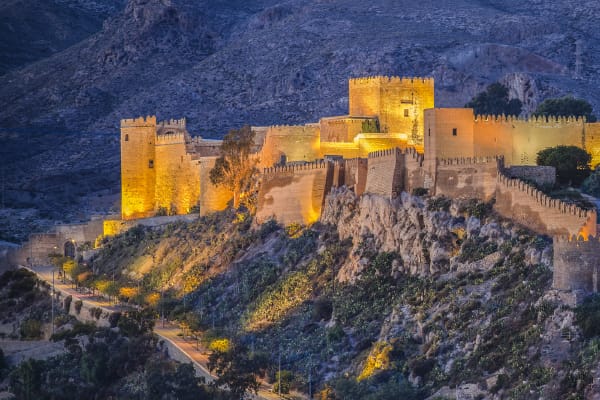
The Alcazaba
A tour of the most important monument in the city of Almería and one of the largest citadels made by the Arabs in Spain.
The Alcazaba was built during the founding of the city by Abderramán III in the year 955. After the reconquest, the Catholic Monarchs and Carlos I managed to reform it.
Direction: C/ Almanzor, s/n, 04002 Almeria
Schedule: Tuesday to Sunday from 9.00 at 18.00h
Phone: 600142984
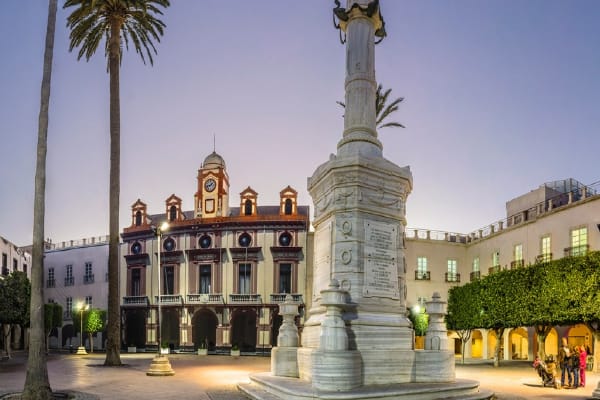
Constitution Plaza
Also called Old Square, It is the oldest square in the city is located in a charming and secluded corner. It was a place of games, festivals and bulls, civic processions and parades.
In Muslim times it was an irregular square and constituted the main souk. Already with the christians, It will be known as the square of the "Game of the Reeds". Its current appearance will take it in the nineteenth century with arcades on the ground floor and two-storey houses. It is a square that has a slightly trapezoidal plan, and that maintains the characteristic of the closed and arcaded squares of the 19th century.
Direction: Constitution Plaza, 9, 04240 Viator, Almeria

Hall of Fame
A section of Poeta Villaespesa street is the so-called Paseo de la Fame de Almería, in which tribute is paid to the most outstanding actors and filmmakers who have worked in the province. Patrick, Omar Sharif, Ridley Scott, Denis O ‘Dell, Angela Molina, Terry Gullian y Schwarzenegger, are some of the names displayed on these stars of fame.
Direction: C / Poeta Villaespesa, 2, 04001 Almeria

Cathedral
The Plaza designed in the mid-19th century, has undergone several renovations, the last in the year 2000. In it, the monumental façade that presides over the cathedral-fortress stands out, 16th century, with its main Renaissance portal.
The cathedral is start building in the year 1524, after the earthquake that in 1522 destroy the first, which was located in the Medina, about the Old Great Mosque.
Its main characteristic is that of being a cathedral-fortress, because it is built both for religious worship and to shelter the population from the attacks of Barbary pirates.
Direction: Cathedral Square, s/n. 04001 Almeria.
Schedule: Monday to Saturday from 9.00 at 19.00h
Phone: 950 234 848
PrevI: 5€ (includes audio guide).
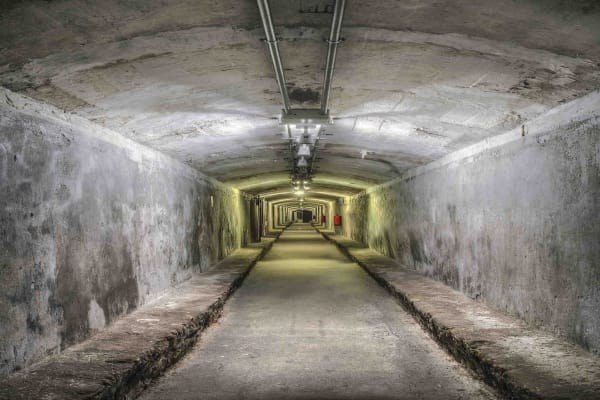
The Civil War Shelters
These shelters are underground galleries designed by the architect Guillermo Langle Rubio, a 9 m. depth to safeguard human lives from the bombings that occurred in the city. Of the 4,5 km designed by the architect have recovered almost 1 km., that coincides with the main artery: the Paseo de Almería.
In its attractiveness it has recreated spaces: pantry warehouse, Guillermo Langle shelter and the operating room, with all the instruments of the time. Shelters that began to be designed in 1936, but to be built in February 1937 and ended in 1938.
Direction: Manuel Pérez García Square, s/n. 04001 Almeria.
Phone: 950 268 696
General rate: 3,00 €. 2,00 € for children under 18 years

The medina
It is the primitive nucleus of the city. Abderramán III, founded Almería in the year 955 (X century), walling the nucleus of the Medina and having a fortress built in that century to defend the city, and a major mosque for prayer.
It extended from Avenida del Mar to Calle de La Reina. He crossed it diagonally from the Door of the Image (at the beginning of Reina street) to the Exit or Relief (on Socorro street), the Pechina road or Real de la Almedina street, belonging to the medina caliphal, whose layout is preserved.
Direction: C / de la Almedina, 04002 Almeria
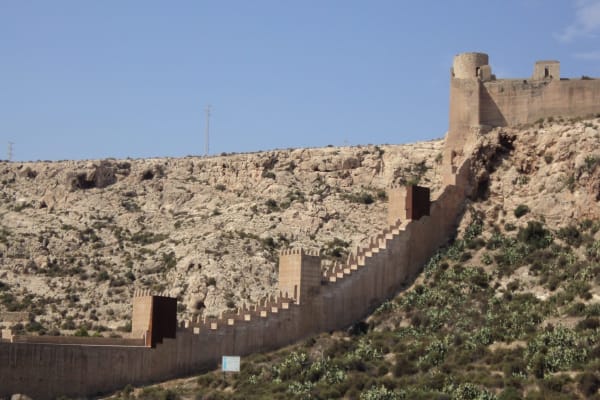
Jayrán wall and Cerro de San Cristóbal
Starting from the Alcazaba and descending north through the Barranco de la Hoya, It crosses a wall line that reaches the Cerro de San Cristóbal and was built in the time of King Jairán (1012-1028) in the eleventh century.
On the hill, known in Muslim times as Mount Laham, there are seven towers, three Muslims with a square plan and four Christians with a semicircular plan. These were built by the Templars of Alfonso VII, that made the place a fortress-chapel after the Christian conquest of the city under the command of Alfonso VII's troops in 1147.
Direction: San Cristobal Road, 24, 04003 Almeria
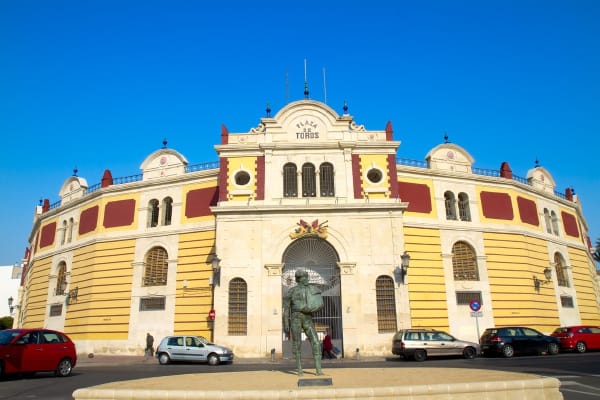
Bullring
The old Bullring was built in 1849. At the end of the century it was small and uncomfortable for the needs of the local bourgeoisie, that it was getting more and more numerous and rich. For this reason, a joint stock company was organized (directed by the most representative of the Almeria bourgeoisie), who bought the land for the new plaza in the "Huerta de los López", at the end of Calvario street.
Direction: C / Calvary
Schedule: Tuesday to Thursday from 9.00 at 5:00 p.m.
Phone: 629328194
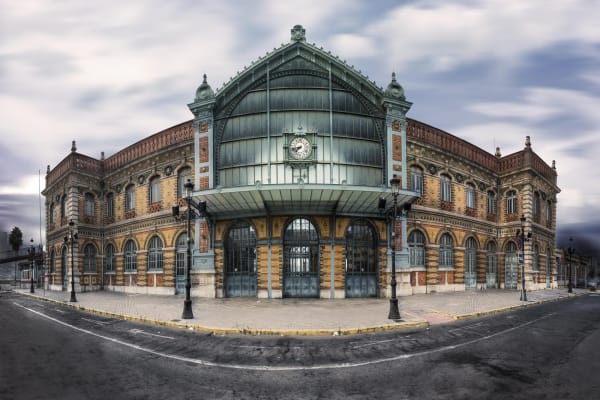
Train station
The birth of the railway in Almería is essentially linked to the extraction of iron ore from the inland mountain ranges: in the absence of a cheap means of transport to deliver the Alquife mineral (Granada) and the Sierra de los Filabres (Almeria) to the Port of Almería.
The Almería line- Guadix would be inaugurated in 1895, and the complete line to Linares was inaugurated on 14 March 1899 with what continued allowing the connection of Almería with the rest of the nation.
Direction: Railway Station Square, S/N, 04006 Almeria

The Corralete
El Corralete or Ancón beach, It is the last beach of Almería to the east and is located in the Natural Park of Cabo de Gata-Níjar. Of 600 meters in length its crystal clear waters and its sunsets are undoubtedly impressive. To access the beach you have to go up the lighthouse road, that gives us impressive views of the entire bay of Almería and especially of the area of Las Salinas and the Cabo de Gata Lighthouse.
The beach has sand and pebbles but does not have shower services or specific accesses for the disabled.
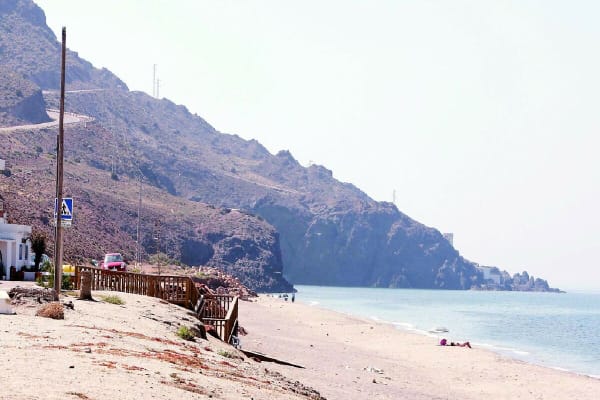
La Fabriquilla
La Fabriquilla is the last beach on the esplanade of Las Salinas prior to the ascent to the Cabo de Gata Lighthouse and that dies supported by volcanic cliffs.
With a length of 600 meters, white sand and crystal clear water. Next to this beach, easy access and parking, there are some establishments to taste the gastronomy of the area. Its occupation during the summer months is very high.
It is also the departure area for canoes for visits to the volcanic area of Cabo de Gata and the sirens reef..
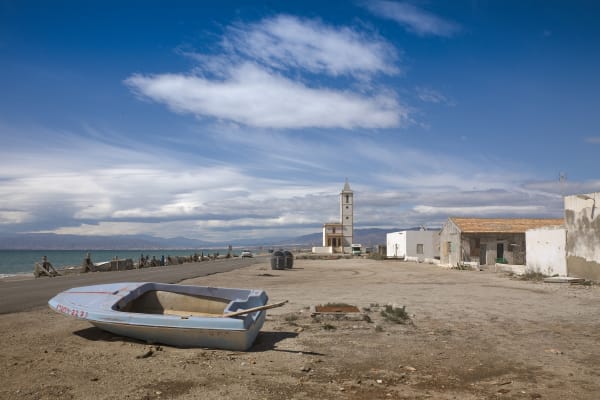
Almadraba Monteleva
The Almadraba de Monteleva Beach is the eastern extension of Las Salinas beach and belongs to the small town of the same name.
Start with the impressive view of the Iglesia de las Salinas, the boats and traditional arts of the fishermen and the facilities of the salt flats and their mountains of salt.
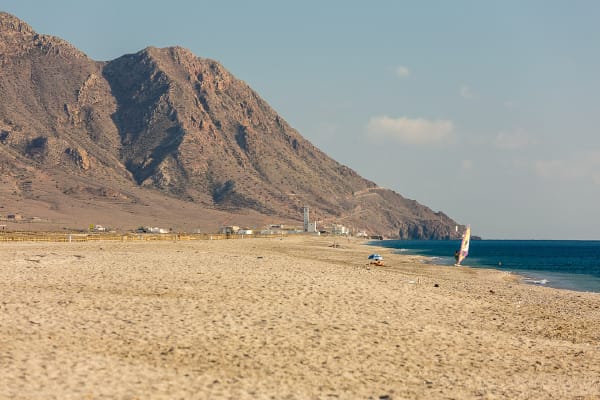
Las Salinas
It is considered one of the best and most beautiful beaches in the entire province of Almería and the most extensive. More of 5 km. rectilinear beach with a width close to the 100 meters. It is located in the Natural Park of Cabo de Gata-Níjar. Its fine and natural sand is one of its great attractions, next to its crystalline waters.
It should also be noted that it runs next to the Salinas, which is also a very important point for bird watching. Another point of interest is the Iglesia de las Salinas, iconic image of the Natural Park.
For its virgin character, the beach lacks amenities like showers or disabled access

The Carob
La Garrofa beach is the last beach on the coast of the city of Almería heading west.
It is a cove of something more than 100 meters in length of pebbles with normally crystalline water. It is located between cliffs and next to the campsite of the same name, through which you have to pass to access the beach.
This beach has a diving club and the facilities of the campsite itself, which is prepared for both tents and caravans.
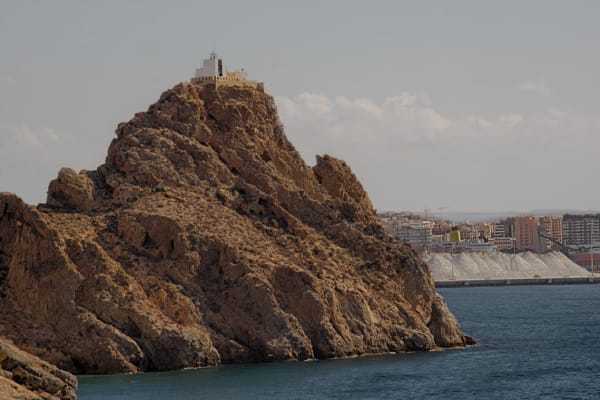
San Telmo
The San Telmo Lighthouse Beach, It is a beautiful sandy cove located between cliffs. It is located at the exit of the city of Almería heading West. Has less than 100 meters in length and has low occupancy throughout the year, having a complicated access.
It is essential to park in the nearby service area (To the lady) and move along the road towards Aguadulce. The beach lacks services.

San Miguel
The beach of San Miguel or Zapillo beach is one of the two great urban beaches of the city. It is a beach of 1.550 meters in length and an average width of about 40 meters composed of sand, both in the rest area and in the bathroom area.
This beach is located next to the city's promenade, with access for people with disabilities, bike lane, showers, childish games, commercial and restaurant areas.

New Almeria
The beach of Nueva Almería, or also called the Thermal, it is the second most important beach in the city. It is an extension of the Zapillo beach from the Maestro Padilla Auditorium area heading east.
It lasts a few 1.500 meters long with a width of about 40 meters composed of sand. It runs alongside the second phase of the city's promenade with access for people with disabilities, bike lane, showers, commercial and restaurant areas.
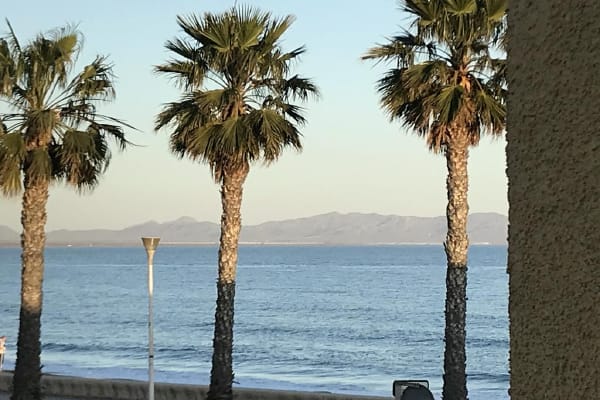
Costacabana
Costacabana beach is located next to the promenade of the residential area of the same name. It is a sandy beach and small pebbles of 1.200 meters in length that has some stone breakwaters that favor a less impact of the waves on the coast.

The Perdigal
El Perdigal is the beach in the neighborhood of Alquián that has a length of 2.450 meters. Its composition is sand and some pebbles. It is therefore a virgin and very quiet beach since it does not have much occupation, but the swell is usually strong.
It is normal to see small fishing boats.

The Toyo
The beach is in front of the urbanization created as accommodation for athletes during the Mediterranean Games of the 2015. It is located next to a promenade of palm trees and native plants of the province with an extension of 1.300 meters and a low occupancy level.
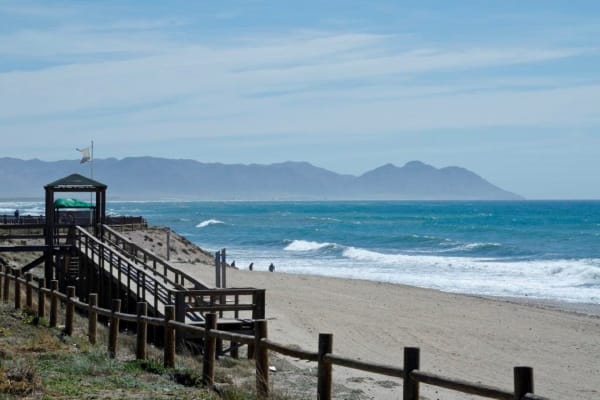
Retamar
Retamar is an urban beach that is located next to the residential area of the same name and next to its promenade. It has an extension of about 1.200 meters and its composition is sand and pebbles.
The beach has magnificent views of Cabo de Gata
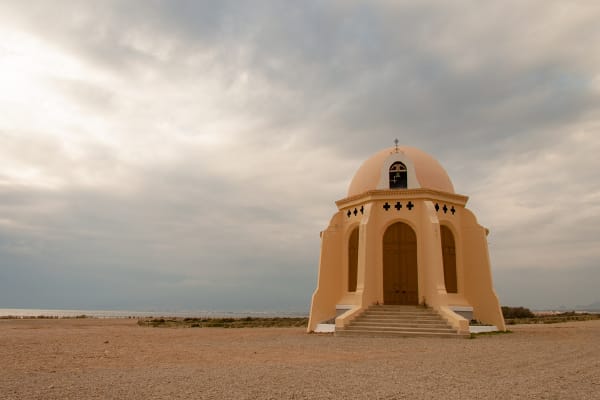
Torregarcia
Torregarcía beach is a virgin beach east of Almería, after Retamar and almost 2.000 meters long. Of sand and pebbles, The visitor is recommended to wear booties in some of its areas.
It is accessed through dirt roads suitable for any type of vehicle and frequented by cyclists. It has three elements of tourist interest, the hermitage of Torregarcía, an old 16th century watchtower and remains of ancient Roman salted fish.
In a specially protected area of the Natural Park, its virgin nature means that it lacks services such as showers or access for the disabled
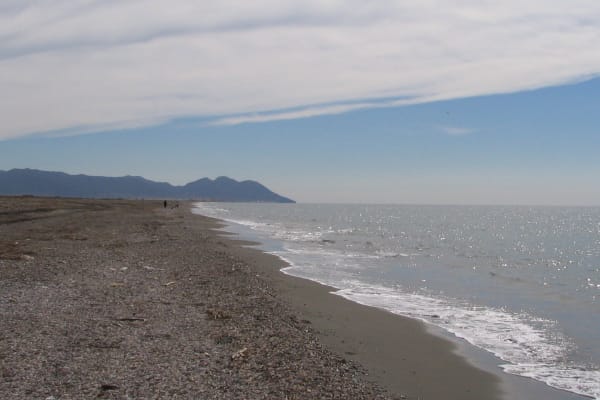
The Grinders
It is one of the virgin beaches of the municipality and is located between the Cañada de las Higueras and the Rambla Morales. Has an extension of 3.750 meters with composition of sand and pebbles.
It has a low level of occupation due to its access on dirt roads where it is necessary to cross the Cañada de las Higueras. This allows great peace of mind. What's more, In some bathing areas, the use of booties is recommended.
At the end of the beach at its eastern end, it is interesting to visit the small lagoon where it is possible to see migratory birds for much of the year.

The Isleta del Moro
La Isleta del Moro is located in a small fishing and tourist center belonging to the Cabo de Gata-Níjar natural park.
Next to a rock, the Isleta del Moro was visited by Arabs and pirates in search of legendary treasures. The town originated in the 19th century and its Berber leader Mohamed Arráez gave its name to the islet.
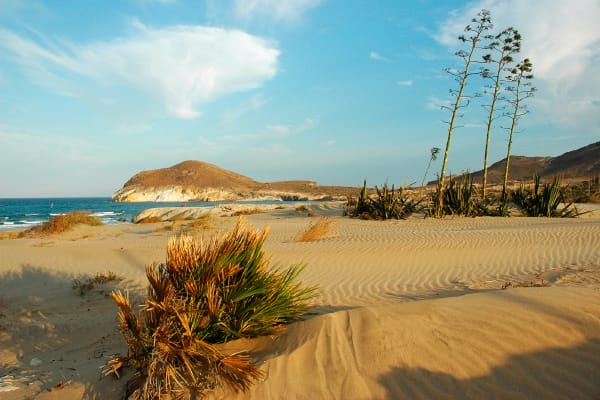
Los Genoveses Beach
The beach that occupies the entire bay, about a kilometer in length, It is surrounded by small dunes where the typical vegetation of the park grows.
In the northern part of the beach we will find a small grove in which to take refuge from the radiant summer sun and in the southern area you can be more sheltered from the wind.
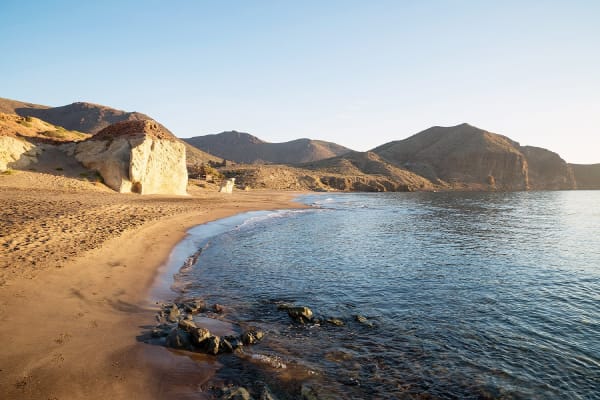
The Natural Park of Cabo de Gata Níjar
The natural park of Cabo de Gata Níjar is characterized by having exceptional biogeographic variety that make it unique in Europe.
From its amazing coastline created from ancient volcanoes, where do you saw, ravines, cliffs and virgin coves surprise their visitors with their peculiar and original flora, fauna, history and rich ethnography.